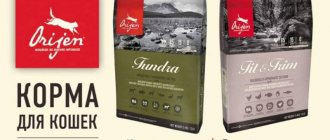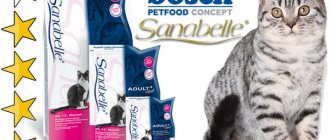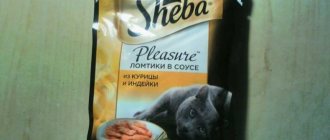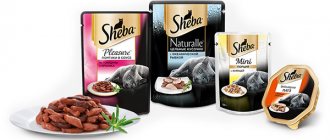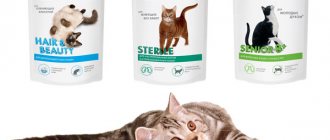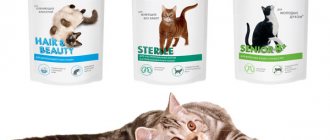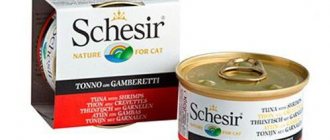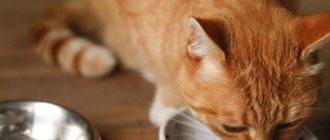Economy class food in itself is the real enemy of pet health. Most of these foods can be harmful to your pet’s body, despite their availability and cheapness.
Economy class feed is made from vegetable protein with a small addition of substrate from meat industry waste: skin, horns, hooves, organs damaged by disease, etc. The “meat” content is 4-6%, and this meat is obtained from meat industry waste. In addition, this class of cat food includes ballast filler substances: cellulose, starch, and mineral additives. For balance, vitamin complexes are added to these feeds in order to somehow increase the biological value. Chemical dyes, flavors, and taste enhancers are widely used.
This food can only be used occasionally for cats. Constantly eating such “junk” food causes severe gastrointestinal diseases in cats.
All veterinarians and experienced cat breeders are sure that there is no answer to the question - which economy-class food is the best. However, in case of urgent need, you need to be able to choose this type of ready-made food as competently as possible.
Kitekat
Kitekat – economy class food. It is actively advertised in the media. It is made mainly from offal - bones, entrails, skin. It contains many different flavorings and colorings. The food differs only in taste. Animals quickly get used to the food, and it is quite difficult to switch them to another food. This is most often due to the presence of catnip in it.
Kitekat cat food declares that it contains no flavorings or flavor enhancers. However, artificial additives are still present. From harmless to carcinogenic. These are stabilizers and preservatives.
Advantages: financial accessibility. Widely known thanks to advertising. A wide range of flavored food for adult cats. Dry food is complete and does not crumble.
Disadvantages: the feed has an opaque composition. Cheap ingredients. Only analytical data are provided. There is no specific gravity or detailing of ingredients. Therefore, the inexpensive price is questionable. Can cause illness in animals. Kitekat does not have the best reputation among cat owners. And in the reviews of veterinarians, the topic of cheap food is a sore point. Inconvenient packaging, no fastener.
Whiskas
Whiskas is an international cat food brand. Whiskas first appeared on the market in 1958. It was the first animal food product to be commercialized by the American company Mars.
The pride of the company is the Waltham research and development center, which is located in the UK. Leading experts in the field of veterinary medicine and pet nutrition are developing new concepts that are used in ready-made food formulas for cats. The laboratory's most famous achievement is the recognition of the important role of taurine in cats. Cats are not able to produce this substance on their own and can only get it from food, so Whiskas was the first food to which it was added. This was a significant breakthrough in the field of ready-made diets for domestic cats. Currently, all complete feeds include taurine.
Advantages: the food is always ready to eat, it does not need to be specially prepared. The balance of vitamins, minerals, etc. is maintained. necessary substances. You can leave the cat the daily norm immediately if the owner plans to be absent for some time. Low price.
Disadvantages: you cannot combine ready-made food and homemade food; you always need to have a supply of ready-made food. Dry food must be washed down with water. Economy class food, which includes most Whiskas products, is the lower bar for the quality of pet nutrition. High price for canned food (wet food). Reviews from veterinarians and most buyers are disappointing - this food, when consumed for a long time, causes diseases such as urolithiasis and eye diseases.
What is economy food?
As you know, all cat food is divided into four classes:
- Holistic.
- Super premium.
- Premium
- Economy
Of these, economy class feed has the lowest quality. But, as a rule, they are quite popular.
This happens for reasons such as:
- Active advertising. Manufacturers of economy-class food prefer to invest in marketing rather than quality, which is why television screens show consumers healthy, active cats and phrases like “recommended by veterinarians.”
- Good taste of economy feed. All cats eat economy food, even the pickiest ones. And often the owners, seeing how the pet licks its lips contentedly and asks for more after “Kitiket” or “Whiskas”, immediately run to the store for a new bag. But this is not at all due to the balanced and natural composition, but due to the addition of flavor enhancers and flavorings.
- The owner’s reluctance to understand the composition of the feed. Of course, every owner loves their animal, but not everyone has the necessary knowledge or time to figure out what is good for their pet.
- Lack of funds among the population. Economy class food is very cheap, almost everyone can afford it.
The popularity of economy-class feed is the result of advertising
Absolutely all felinologists, breeders and veterinarians say: economy-class food is a slow-acting poison for cats. The reason for this is the composition. It includes:
- a large amount of corn and other grains (sometimes the main ingredient);
- no more than 4–5% meat (and often it is completely absent, replaced by meat and bone meal, offal and fat);
- flavoring, aromatic and coloring additives;
- salt and sugar content;
- low-quality products of plant origin (beet pulp, peas, sunflower oil, etc.).
Of course, each food has its own composition, and some manufacturers even add vitamins and beneficial amino acids. However, all the benefits of such food are killed by its basic composition.
Some owners may think that there is nothing wrong with corn, since it contains many useful substances. But this is a misconception. The dangers of corn for cats are as follows:
- High carbohydrate content. Cats get most of their energy from proteins, and only 20% from carbohydrates. Therefore, such a carbohydrate diet will only lead the cat to obesity. Of course, corn contains vegetable protein, but it is poorly absorbed by carnivores.
- Starch content. Corn starch has a high glycemic index (85 points), which means it dramatically increases glucose levels in the body. With constant consumption of such a product, the cat will easily develop diabetes.
- Niacin acid. This substance is known as vitamin PP, which is very important for the brain. Its absence causes dementia and skin problems. Corn contains it in abundance, but it is indigestible even by humans, and even more so by carnivorous cats - they get it from meat.
- Folic acid. Carnivores can only absorb it from fresh greens and meat, but not from corn.
Corn is harmful to carnivores
Meat and bone meal and fat are even more dangerous. They are likely to contain the chemical pentobarbital, which is used to euthanize animals. Salt and sugar should not be in animal feed at all, as they do not provide any benefit to them.
Rice, which is sometimes found in feed, also contains starch with an equal glycemic index (85).
In addition, various preservatives, antioxidants and other chemicals are added to such foods. They are dangerous for reasons such as:
- The antioxidant ethoxyquin, which is also used as a pesticide, is used in the feeds of this segment.
- Preservatives BHA and BNT are often used; they are classified as toxic and carcinogenic substances. Please note that these food additives are prohibited for use in human food.
- To ensure that cats eat such food with pleasure, attractants (substances that attract by smell) are added to economy-class food.
The purpose of economy class food is not to satisfy the cat’s natural needs for vitamins, minerals and other nutrients and beneficial substances, but to fill the stomach.
The health of pets directly depends on nutrition
Another danger relates to dry economy food. Since food in this class is designed only to satisfy hunger, their daily intake is quite high. When consuming dry food, cats need to drink more, but their sense of thirst is naturally dulled.
Therefore, all high-quality dry food is high-protein and only a small amount is required. But economy-class food with low water consumption is highly likely to cause urolithiasis and other kidney problems.
Summarizing all of the above, we can say with confidence: the bulk of economy-class food will not bring any benefit to the cat. However, there are situations when, for one reason or another, owners are forced to switch their pet to this diet. In this case, remember that it should not last longer than 6–7 months.
Constant uncontrolled consumption of economy feed can lead to obesity
Several years ago, my mother picked up a stray cat on the street. The animal turned out to be very picky about food, and the only food that the cat agreed to eat was economy class food. Unknowingly, she fed it to her cat for two years. The result was obvious: the cat’s fur was coming out in clumps, she gained weight, and from an affectionate “purr” she turned into an aggressive and uncontrollable creature. As a result, the kitty had to be given to friends, where it was fought, but they switched to natural food. Within a few months, after visiting the cat, I noticed a significant improvement in health and character. But some behavioral problems, unfortunately, still remain.
Friskies
Friskies dry food for cats is produced by Purina (Nestle Purina PetCare Company, USA). For the Russian market, production is carried out in Russia.
“Friskies” belongs to the economy class; in addition to it, it also produces such food for cats and dogs as ProPlan (premium class), One (economy class), Felix, Darling, Chat Chow (Dog Chow), Gourmet.
The bright yellow packages, which are sold in pet stores and supermarkets, are especially popular among cat owners.
The product is available in two forms: dry (packages of 0.4 kg, 2, 10 kg); wet (packs of 0.1 kg).
Advantages: suitable for feeding pets of all age categories. A self-balanced dish. It can be used as daily food, but it is better, of course, to combine it with dry food. A wide range that is easy to find on sale. Friskies granules are a variety of crackers: yellow, green, carrot and sandy.
Disadvantages: absolute economy. There is practically no meat in the composition. Additives with code E are listed on the packaging in a line. There is no need to talk about the presence of preservatives. Opened canned Friskies are stored for no more than 2 hours at room temperature.
Comparison table of characteristics
| Manufacturer | Country TM | Type of diet | Class | price, rub. |
| Whiskas | USA | wet, dry | economy | 70 |
| Purina Cat Chow | Hungary | wet, dry | premium | 103 |
| Gourmet | France | wet | economy | 29 |
| Sheba Pleasure | USA | wet | premium | 30 |
| All Cats | Russia | wet, dry | premium | 78 |
| Felix | Hungary | wet, dry | economy | 19 |
| Kitekat | USA | wet, dry | economy | 55 |
| Perfect Fit | Germany | wet, dry | economy | 53 |
| Our brand | Russia | wet, dry | premium | 69 |
| Native food | Russia | wet, dry | premium | 94 |
To keep your cat healthy, you need to make sure you have the right nutrients in your cat's diet. When choosing the best food, you need to focus on options that contain high-quality proteins and stay away from those that are high in carbohydrates and artificial ingredients.
Darling
Darling dry cat food is produced by the local division of Nestle Purina PetCare Company, namely Nestle Russia LLC.
The food is a fairly popular diet for cats and kittens. Should you give it to your pet? There is a lot of controversy on this topic in the media, since the benefits of cat food are questionable, the harm in many cases is obvious, and the composition leaves much to be desired. It is worth understanding how beneficial this diet is for your cat.
Darling dry cat food is quite good, cats eat it with pleasure, it looks very appetizing, and the smell generally makes the cat run to it as fast as it can, but is all this an advantage?
Advantages: affordable price. The food is balanced, suitable for different age categories, cats of different sizes. Easy to find in absolutely any pet store, as well as in online stores. Cats usually like this diet.
Disadvantages: composition, since there is a lot of fiber, little meat, there are dyes, flavor enhancers and preservatives, antioxidants, and this is partially stated on the packaging. If you use only this food for a long time, it can have a detrimental effect on the health of your pet. Reviews from veterinarians and animal owners confirm this.
What types of economy class food are there?
Economy class feeds, like others, are divided according to the form of release:
- dry;
- wet;
- canned food
And by purpose:
- for cats;
- for kittens.
Economy class feeds are also divided by type of purpose
The main brands of economy feed are:
- Whiskeys;
- KiteKat:
- Felix;
- Frieskies;
- Gourmet;
- Purina One and Pro Plan;
- Cat Chow;
- Perfect Fit;
- Protail;
- Sheba;
- Wellkiss;
- Stout.
Some of these manufacturers also produce special foods, such as Whiskas Special for cats with sensitive digestion or Whiskas for older cats.
Some economy class manufacturers produce special ones. feed, but they differ little in composition from regular lines
Rating of the best economy food for cats and kittens
Among economy-class foods, there are also those that do not cause any particular harm to the cat (although they also do not bring any benefit). If for some reason you decide to switch your cat to economy food, you should choose one of the top ones.
Table: top 6 best economy class food for cats and kittens
| Name | Release form | Compound | Advantages | Flaws | Price |
| Cat Chow Lamb and green beans for cats over one year old | Wet (spauchi). |
| Contains vitamins, amino acids and minerals. |
| 40 rubles/pouch |
| Purina Pro Plan Dental+ | Dry |
|
|
| 300 rubles/0.5 kg |
| Gourmet Perle with lamb for adult cats | Wet (spauchi) |
|
|
| 30 rubles/pouch |
| Stout with chicken and rice for adult cats | Dry |
|
|
| 550 rubles/2 kg |
| Cat Chow for kittens with poultry | Dry |
|
|
| 500 rubles/1.5 kg |
| Purina Pro Plan Junior with Turkey (for kittens) | Wet (pouch) |
|
|
| 51 ruble/pouch |
Photo gallery: top 6 economy class feeds
Stout with chicken and rice for adult cats contains preservatives
Gourmet Perle - available in cans and pouches
Purina ProPlan for adult cats - acceptable quality food
Cat Chow for adult cats is one of the best economy food
Cat Chow for kittens with poultry is not bad for economical food
Purina Pro Plan Junior - economy class food for kittens
Meow
Mjau (Meow) feed production is located in one of the most beautiful places in Sweden. It is here that farmers use the least amount of chemicals than in other countries of the world, and Swedish livestock have been a guarantor of the quality and safety of agricultural production for many decades. And according to manufacturers, the raw materials used in Mjau (Meow) feed are of the highest quality, without chemical additives, hormones, dyes and antibiotics.
Reviews for this product are mixed. Some buyers compare it with Kitekat food, but cheaper. However, it is important to understand that Meow food is an economy class food. Its low cost matches its quality.
Advantages: very low price. The food does not have a strong odor, but rather has an appetizing aroma. Almost all the granules are intact, and the food does not feel greasy to the touch. Quite a lot of flavours.
Disadvantages: the composition is veiled. There are animal by-products and grains that are very harmful to the digestive system of cats. Contains preservatives and antioxidants. It is not advisable to use it as a permanent food. Cats become addicted to food.

